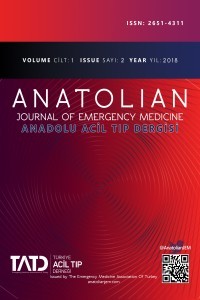
Anatolian Journal of Emergency Medicine
Yazarlar: Halil İbrahim ATALAY, Serhad ÖMERCİKOĞLU, Murat DOĞANAY, Çiğdem ÖZPOLAT, Erkman SANRI, Özge Ecmel ONUR, Arzu DENİZBAŞI
Konular:Tıp
Anahtar Kelimeler:FOCUS,Pulmonary embolism,Echocardiography
Özet: Aim: It’s known that computed tomographic pulmonary anjiography (CTPA) is the gold standard in imaging techniques for pulmonary embolism (PE). Echocardiography and focused cardiac ultrasonography (FOCUS) are the most beneficial bedside diagnostic tools. Our aim was to determine the value of FOCUS in the diagnostic algoritm of pulmonary embolism. Materials and Methods: This study was designed prospectively in a tertiary medical center’s emergency medicine department. All the patients which were presented with dyspnea triaged with Emergency Severity Index triage criteria 1-2, after that if PE was involved in differential diagnosis and the patients whose had Wells score as moderate or high risk randomized for whether to carry out FOCUS or not. The patients who underwent CTPA were included to study. FOCUS protocol consisted of the views of parasternal long axis, parasternal short axis, subxiphoid and apical four chamber views. The ratio of Right ventricle to the left ventricle, right ventricular dilatation, septal flattening, septal paradoxal movement, right atrial and ventricular thrombus, vena cava inferior (VCI) and ejection fraction (EF) were evaluated from these views. Final diagnoses of patients and the statistical significance of FOCUS parameters in the diagnosis of pulmonary embolism was examined. Results: 102 patients were included in the study, of which 45 (44,1%) were women. Patients mean age was 63,8 -+ 15. PE was found as final diagnosis at the 60(%58,8) patients. The FOCUS parameters which were the ratio of right ventricle to the left ventricle over 0,9 [sensitivity %45(%32,12-%58,39) and specificity %80,95(%65,88-%91,40) (p=0,0069)], septal paradoxal movement [sensitivity %21,67(%12,07-%34,20) and specificity %95,24(%83,84-%99,42) (p=0,0182)], full VCI(>21 mm, <%50 collapsibility) and hyperdynamic EF(>%70) relation [sensitivity %28.33(%17.45, %41.44) and specificity %97.62(%87.43, %99.94) (p=0,0004)] were found as the most valuable. Conclusion: FOCUS could be a valuable diagnostic tool that saves lifes in unstable patients by making early diagnosis.